Backbone One Review
Backbone’s One controller turns your iPhone into an excellent mobile console
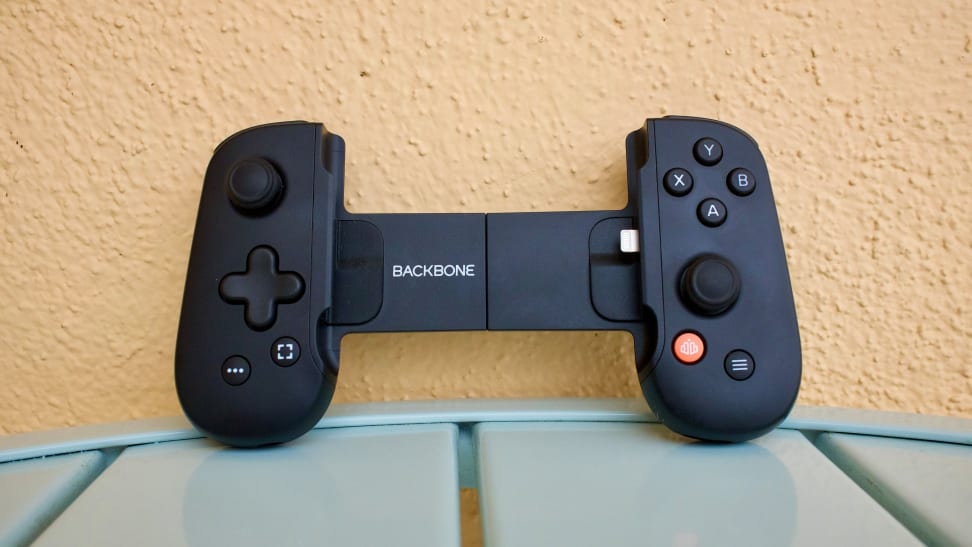 Credit:
Reviewed / Jordan McMahon
Credit:
Reviewed / Jordan McMahon
Products are chosen independently by our editors. Purchases made through our links may earn us a commission.
A good iOS game doesn't need a controller for an enjoyable experience. Retro Bowl, one of my favorite mobile games, strikes a nice balance between functionality and fluid touch controls: Drag your finger back across the display to initiate your quarterback's throw, drag up or down to aim, and release to throw (everything else is about as seamless).
But even a game built for touch screens can benefit from a good mobile controller. After testing Backone's One controller with my iPhone 12 Mini (it works with iPhones from the 6S onward), I'm not sure I can go back to playing Retro Bowl without a controller. It adds a more comfortable grip, more responsive and tactile controls, and free software that makes accessing games easier—all without requiring a charge.
Design
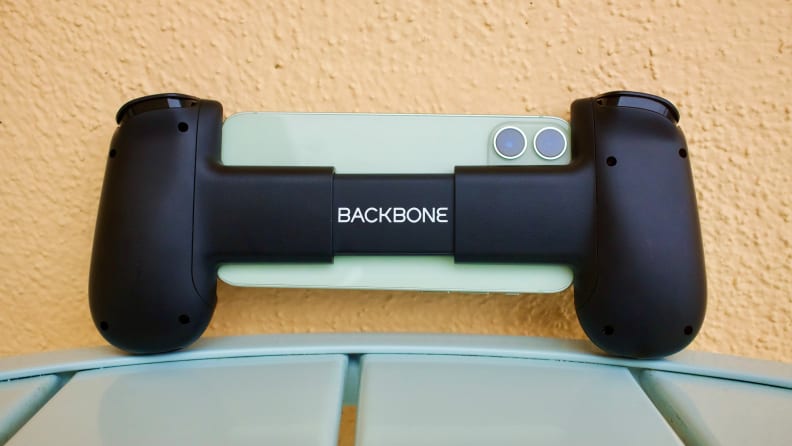
The Backbone One can house nearly any iPhone, and there's an adapter for the 13 Pro and Pro Max's larger camera bumps.
The Backbone One consists of two Joy-Con-like rounded rectangles which house traditional gaming controls (a joystick, D-pad, four lettered buttons, and shoulder and trigger buttons) as well as some Backbone-specific functions. The two rectangles are connected by two pieces of plastic that slide out to make enough space for your phone. Once you've connected your phone to the Backbone's dock connector, the left side of the controller can slide back to the edge of your phone to hold it snugly. It's worth noting, though, that you'll have to take your phone out of its case before sliding it into the One.
The controller itself is sturdy and will keep your phone safely secured in its grip. Throughout a week of testing I didn't have any issues with my phone slipping out, regardless of what angle I held the controller. The controls themselves feel great, too: Joysticks are smooth and responsive and the buttons have a satisfying click to them without feeling stiff.
Backbone has also included some unique buttons that allow you to record gameplay and open the Backbone app (more on that later). There's two ports on the bottom of the controllers: The left side houses a 3.5mm headphone jack, while the right side has a Lightning port so you can charge your phone while you play (especially handy if your game of choice is a major battery-drainer).
Gameplay
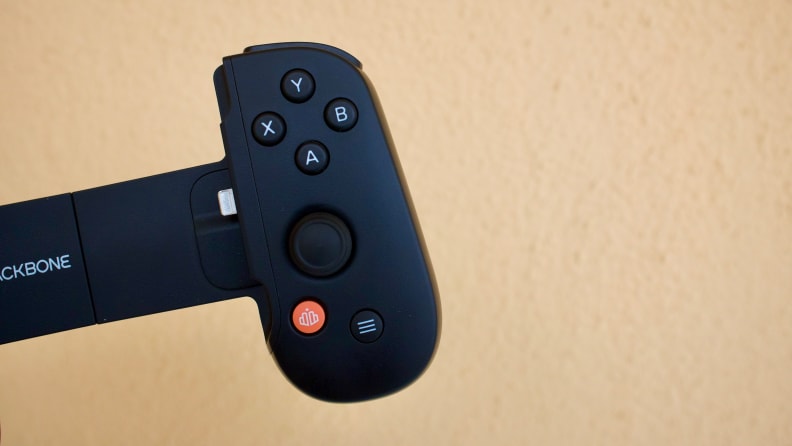
The Backbone's buttons are clicky without feeling stiff, and provide an excellent way to play games on your phone.
Unlike playing an iOS game with a paired PS4 or Xbox One controller, which both rely on a Bluetooth connection that can introduce a bit of lag, the Backbone one connects directly to your device via a dock, which makes response times nearly instant.
Even games that require a quick response time, like Hitman on Google Stadia, only had the typical lag (up to about 25ms) you'd expect while playing a game on a cloud gaming service. But games installed on my iPhone, like Stardew Valley, Dadish 2, and Forager all worked great with no noticeable delay in response time.
Portability
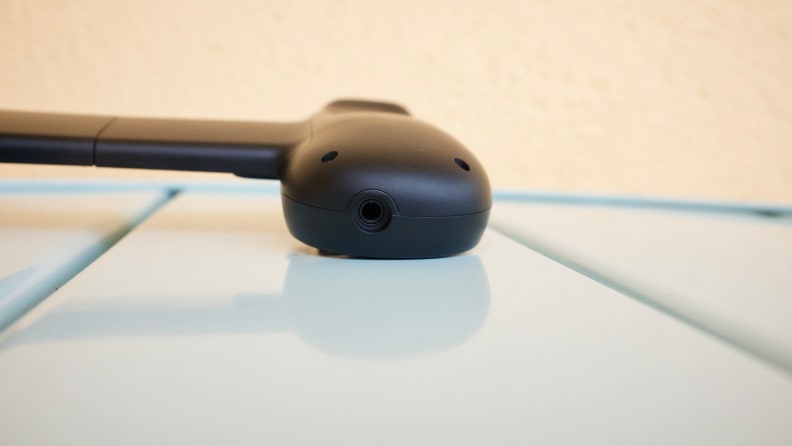
If you've missed having a phone with a headphone jack, the Backbone One is a bulky way to bring it back.
For a good mobile controller to be great, it has to be more than just a good piece of hardware: It has to fit nicely in a bag, too. The Backbone One is a fairly slim controller, about as thick as a Moleskine notebook, but it's also a bit wide at 10.4 inches across. That's not terrible, but it might be too wide to fit into some pockets, as the Backbone doesn't collapse nearly as much as the Razer Kishi V2 controller.
The Backbone's extra width makes sense, though. There's an extra piece of plastic inside the two main pieces that act as a reinforcement for the controller when your phone is attached. This makes sure your phone is held securely while you play, and in practice it works great. As I previously mentioned, I didn't notice my phone wiggling around at all, and the controller itself didn't shift or come loose when in use.
Software
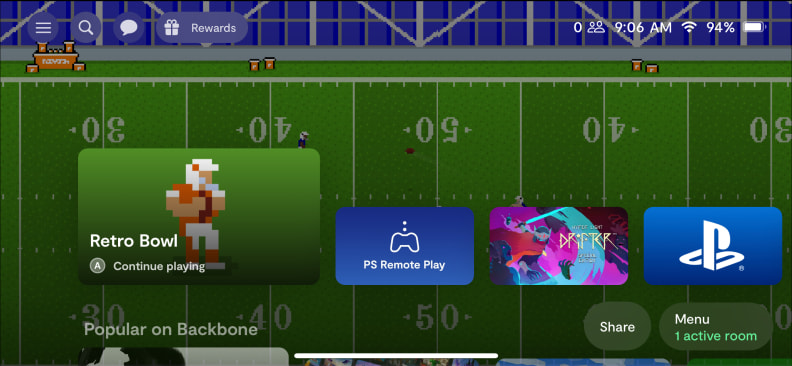
Rather than feeling like unnecessary bloatware, Backbone's app feels like a crucial part of bringing the console experience to your phone.
In addition to a killer controller, the Backbone One also comes with a nice app where you can sift through all your games in one place, browse recommendations for other games to try, manage your recordings, and chat with other Backbone users.
Since iOS doesn't have any way to navigate through your games folder with a controller, Backbone's app adds a speedy way to switch between games without having to pull your hands off the controller.
The app also gives you a way to browse other games that support controllers without having to jump to the App Store. Since the App Store itself doesn't have a great way to track down games with controller support (and App Store descriptions aren't always clear on that either), Backbone's recommendations are a reliable way to find games that will make the most of your new hardware.
Backbone's also added software to record and edit gameplay footage directly on your phone, and share it across a variety of platforms like iMessage or Twitter. You can also add other Backbone users as friends and start parties, just like you can on a console.
Backbone's done a great job of making this app feel like a perk of the hardware, rather than annoying bloatware. The integration with your installed library of games, iOS's App Store, services like Game Pass Ultimate, and social features all make it feel like a cohesive gaming experience, rather than an app tacked on as an afterthought.
Should you buy it?
If you're passionate about gaming on your phone, whether it's via first-party options on Apple Arcade or in your browser via Xbox Games Pass, you should get the Backbone One. It's the best controller you can get for your phone thanks to its fun-to-use buttons and quality hardware, plus excellent software that beefs up the experience with extras like gameplay recording and voice chat. There’s even a PlayStation edition if you prefer Sony’s layout.
It's not as compact as Razer's Kishi, but its hardware feels more durable and the additional software Backbone provides adds a layer that Razer hasn't been able to match. At $100, it's not cheap, but its support for App Store games, as well as streaming services, make it a versatile controller that'll be welcome in any mobile gamer's ensemble of gadgets.


